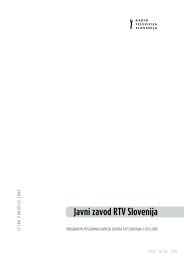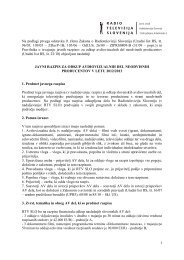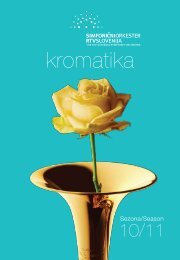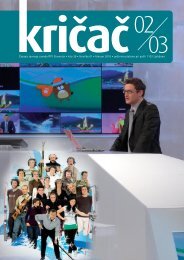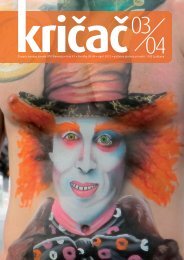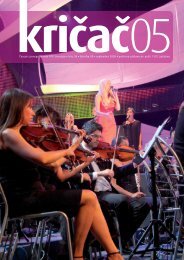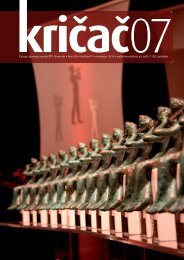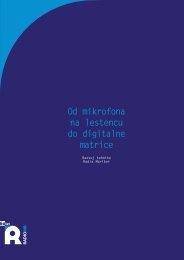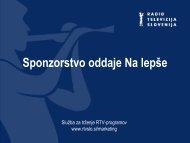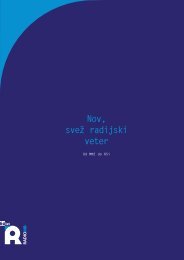Presentation of RTV Slovenia - RTV Slovenija
Presentation of RTV Slovenia - RTV Slovenija
Presentation of RTV Slovenia - RTV Slovenija
- No tags were found...
Create successful ePaper yourself
Turn your PDF publications into a flip-book with our unique Google optimized e-Paper software.
<strong>Presentation</strong> <strong>of</strong> <strong>RTV</strong> <strong>Slovenia</strong>
<strong>Presentation</strong> <strong>of</strong> <strong>RTV</strong> <strong>Slovenia</strong><strong>RTV</strong> <strong>Slovenia</strong> is a public, non-pr<strong>of</strong>it radio-television organisation rendering public service in the field <strong>of</strong> radio, television and otheractivities in compliance with the Radiotelevizija <strong>Slovenija</strong> Act.<strong>RTV</strong> <strong>Slovenia</strong> prepares two national television programmes (TV SLO 1 and TV SLO 2), two regional television programmes (TelevisionKoper/Capodistria and Tele M), one programme for the Italian and Hungarian national community each, three national radioprogrammes (First Programme, Second Programme - Val 202 and Third Programme - Programme Ars), two regional radio programmes(Radio Koper and Radio Maribor), a radio programme for foreign audiences (Radio <strong>Slovenia</strong> International). <strong>RTV</strong> <strong>Slovenia</strong> also includesRadio Capodistria and Pomursko madžarski radio/Muravidéki Magyar Rádió with programmes for the Italian and Hungarian nationalcommunities in <strong>Slovenia</strong>. It also prepares radio and television broadcasts for the Roman ethnic community, radio and televisionprogrammes for Slovene national minorities in the neighbouring countries as well as for Slovene emigrants and migrant workers.Moreover, it also prepares a special national television programme intended for live broadcasts and broadcasting <strong>of</strong> recordings <strong>of</strong>sessions from the National Assembly <strong>of</strong> the Republic <strong>of</strong> <strong>Slovenia</strong> and its working bodies (TV SLO 3).The employees <strong>of</strong> <strong>RTV</strong> <strong>Slovenia</strong> prepare a variety <strong>of</strong> informative, culture, educational and entertainment contents, we create andinterpret the works <strong>of</strong> culture and art, the broadcasts for the Slovene national minorities in the neighbouring countries, emigrants andmigrant workers as well as members <strong>of</strong> the Romany community. In all programmes we respect human personality and dignity, theprinciples <strong>of</strong> unbiased and truthful information, the pluralism <strong>of</strong> opinions, weltanschauung and religions, political independence andautonomy. We ascertain integral and unbiased information and the freedom <strong>of</strong> opinions; we are promotors <strong>of</strong> Slovene culture andencourage culture creativity and the freedom <strong>of</strong> artistic creativity. We educate and develop linguistic culture and protect children andthe young against the contents that could harmfully influence their mental and corporal development.Within the scope <strong>of</strong> <strong>RTV</strong> <strong>Slovenia</strong> the activities are also performed by the Symphony Orchestra, Big Band, the Chamber Choir and theChildren's and Youth Singing Choir, the group <strong>of</strong> music producers, the Nototeka, and the Record Label.1
Financing <strong>of</strong> <strong>RTV</strong> <strong>Slovenia</strong>The Public Service Broadcaster <strong>RTV</strong> <strong>Slovenia</strong> is financed from several sources, namely the <strong>RTV</strong> licence fee, commercial revenues, marketing activities,the finance attributed from the state budget, sponsors and other sources, all in compliance with the Act and the articles <strong>of</strong> association. <strong>RTV</strong> licencefee payers are all those having a radio or television receiver on the territory <strong>of</strong> the Republic <strong>of</strong> <strong>Slovenia</strong> where technical conditions for the reception<strong>of</strong> at least one programme <strong>of</strong> <strong>RTV</strong> <strong>Slovenia</strong> are assured. It is considered that each electricity payer owns a receiver and is thus subject to the payment<strong>of</strong> <strong>RTV</strong> licence fee, unless a person gives a declaration, as stipulated by the Act. There are more than 600,000 active <strong>RTV</strong> licence fee payers. As far ascommercial revenues are concerned the scope <strong>of</strong> advertising is limited to 12 minutes per hour and to 9 minutes in the evening prime time.Structure <strong>of</strong> total revenue in 2007Revaluation revenue 4.7 %Extraordinary revenue 0.5 %Other operating revenue 10.2 %Co-financing revenue 1.6 %Financial revenue 3.0 %Advertising revenue 17.4 %Revenue from <strong>RTV</strong> licence fee 62.6 %Source: Financial Controlling <strong>of</strong> <strong>RTV</strong> <strong>Slovenia</strong>2
Milestones in the development <strong>of</strong> <strong>RTV</strong> <strong>Slovenia</strong>1928 establishment <strong>of</strong> Radio Ljubljana1945 establishment <strong>of</strong> Radio Maribor1949 establishment <strong>of</strong> Radio Koper/Capodistria1957 first television broadcasting1965 first radio airing in stereo technique1966 first television airing in colours1971 beginning <strong>of</strong> activities <strong>of</strong> Television Koper/Capodistria1975 erection <strong>of</strong> a new <strong>RTV</strong> Centre in Ljubljana1984 introduction <strong>of</strong> teletext1985 introduction <strong>of</strong> a programme for foreign audiences1986 beginning <strong>of</strong> digitalisation1993 erection <strong>of</strong> the first terrestrial satellite station in Ljubljana1997 first test <strong>of</strong> DAB (Digital Audio Broadcasting)1998 introduction <strong>of</strong> digitalisation <strong>of</strong> radio (DALET), initiation <strong>of</strong> regular broadcasting <strong>of</strong> programmes <strong>of</strong> <strong>RTV</strong> <strong>Slovenia</strong> via the satellite Hot Bird 33
1999 introduction <strong>of</strong> digitalisation on television2000 erection <strong>of</strong> the second terrestrial satellite station in Domžale2002 initiation <strong>of</strong> multimedia activity, introduction <strong>of</strong> web sites www.rtvslo.si2004 opening <strong>of</strong> a new <strong>RTV</strong> studio in Lendava for the needs <strong>of</strong> the Hungarian national community2005 introduction <strong>of</strong> RSS technologies2006 switch to regular broadcasting <strong>of</strong> programmes <strong>of</strong> <strong>RTV</strong> <strong>Slovenia</strong> via the Hot Bird 8 satellite2007 test broadcasting <strong>of</strong> TV SLO 3, i.e. parliamentary programmeProgramska enota Televizija <strong>Slovenija</strong>4
Television <strong>Slovenia</strong>Informative ProgrammesOne <strong>of</strong> the fundamental missions <strong>of</strong> a public television is objective,reliable, high quality and timely presentation <strong>of</strong> topical informativecontents. The informative programme has realised this mission withits numerous daily-news broadcasts, extended informative broadcastsand confrontations in studios. Our daily-news broadcasts <strong>of</strong>fer ourviewers the latest and most topical information from <strong>Slovenia</strong> andabroad from different fields extending from politics, economicsto culture. Our extended informative broadcasts cover all topicalissues that are explained in more detail and add the latest news. Inbroadcasts based on the confrontations <strong>of</strong> different people we try tocast a light on problems and to explain them in co-operation withexperts, representatives <strong>of</strong> civil society, politicians and others.5
Culture and Arts ProgrammesThe broadcasts <strong>of</strong> the Editorial Department <strong>of</strong> Culture and Arts Programmespromote Slovene culture, encourage cultural creativity and the freedom <strong>of</strong>cultural creativity, they educate and develop the culture <strong>of</strong> language. Withits versatility - the programme namely consists <strong>of</strong> as many as seven EditorialDepartments (Domestic Films and Serials, Documentary Programme,Children's and Youth Programme, Education Programme, Broadcastson Culture, Foreign Feature Programmes, Religious Programme, SeriousMusic and Ballet) - and high level <strong>of</strong> production, the editorial departmentmakes rich contributions to the output <strong>of</strong> Television <strong>Slovenia</strong>. The EditorialDepartments prepare numerous television and documentary films,Slovene featured series and serials, drama plays, broadcast the recordings<strong>of</strong> concerts, ballets, operas and other events <strong>of</strong> culture, broadcast holymasses, prepare religious broadcasts and the broadcasts for children andyoung adults. We also present the artists <strong>of</strong> music, dance and ballet andtheir works, we perform the work <strong>of</strong> a majority <strong>of</strong> opera and choir corpuses<strong>of</strong> <strong>Slovenia</strong> and we dedicate a special attention to the national versatility<strong>of</strong> the films shown, because we prefer European cinematography and othernon-American productions. Our viewers are daily <strong>of</strong>fered information fromthe world <strong>of</strong> culture and are invited to attend cultural events. Moreover,we have been known to propagate reading habits among our viewers <strong>of</strong>Television <strong>Slovenia</strong> for many years.7
Entertainment ProgrammeEntertaining broadcasts are scheduled in the programme especially at weekends when the viewers look for somewhat more relaxation, easy topicsand entertainment. The entertainment programme thus prepares different music broadcasts covering polka music, Slovene and alternative music,Sunday family and trend broadcasts, a talk-satiric broadcast and also provides information on tourism and travellers' destinations. We have beenpreparing one-time projects for many years, like EMA, Slovenska popevka, Slovenska polka in valËek. We prepare programmes for and cover a variety<strong>of</strong> charity concerts and the awarding <strong>of</strong> the Frane MilËinski-Ježek Award.
Sports ProgrammeThe core concern <strong>of</strong> the Sports Programme <strong>of</strong> TV <strong>Slovenia</strong> is oriented towards assuring top quality and especially objective and integral reporting onsports events and on its problematic in <strong>Slovenia</strong> and abroad. The Sports Programme covers a majority <strong>of</strong> important domestic sports events, where <strong>RTV</strong><strong>Slovenia</strong> acts also as a host broadcaster, i.e. direct producer <strong>of</strong> signal, and also numerous international world sports events, like the Olympic Games,European and world championships. We should not forget to mention that we have a tradition <strong>of</strong> preparing technically and technologically demandingdomestic projects, like the men's alpine skiing world cup in Kranjska Gora, Zlata Lisica on the Pohorje and ski jumps in Planica.Regional Television Programme MariborWith its broadcasts and contributions <strong>of</strong> high quality the Regional Television Programme Maribor strives to reach better recognisability <strong>of</strong> the regionwithin the scope <strong>of</strong> national programmes. We prepare contributions for national informative broadcasts, more extensive feature recordings for theneeds <strong>of</strong> weekly national broadcasts, agricultural broadcasts, entertainment and culture broadcasts, sports transmissions and the transmissions <strong>of</strong>holy masses.Regional Television Programme Koper/CapodistriaThe informative broadcasts <strong>of</strong> The Regional Television Programme Koper/Capodistria cover the events in the region and across the boarder. We alsoact as a collective correspondent and provide information for the informative and culture programmes <strong>of</strong> Television <strong>Slovenia</strong>. The Regional TelevisionProgramme Koper/Capodistria does not only prepare regional broadcasts; one <strong>of</strong> its fundamental tasks is also providing information and connection<strong>of</strong> the Slovene minority in Italy with the mother country as well as preparing original broadcasts on our minority. Apart from the mentioned contentswe also prepare documentaries, sports, agricultural, children's, youth, entertainment and humanitarian broadcasts. We are co-creators <strong>of</strong> the morningprogramme with the Maribor and Ljubljana editorial departments, and help create »ezmejna TV together with the Slovene and Italian Programme RAITrieste and the Italian programme in Koper.11
Programme output <strong>of</strong> Television <strong>Slovenia</strong> in 2007 - in hours (without teletext and info channel) - Number <strong>of</strong> hours: 13,593Religious broadcasts 0.9 %TV plays 1.1 %Sport 8.9 %Entertainment 7.2 %Advertisements 6.2 %Broadcasts for childrenand young people 10.5 %Promotion 3.4 %Series 5.8 %Education 1.6 %Current-affairs broadcasts 21.5 %News and bulletins 8.7 %Documentaries 8.2 %Other broadcasts 1.3 %Films 9.1 %Music 5.6 %Source: Programme Controlling <strong>of</strong> <strong>RTV</strong> <strong>Slovenia</strong>Aired programme <strong>of</strong> Television <strong>Slovenia</strong> in 2007 - in hours (without teletext and info channel) - Number <strong>of</strong> hours: 12,291Production origin/AiringProducer’s countryOwn production- premiere 31.2 %Other 6.4 %USA 4.6 %<strong>Slovenia</strong> 64.1 %Repeats 43.8 %Other production- premiere 25.0 %Europe(without <strong>Slovenia</strong>) 24.9 %Source: Programme Controlling <strong>of</strong> <strong>RTV</strong> <strong>Slovenia</strong>12
Programme output <strong>of</strong> the Firsth Programme <strong>of</strong> Television <strong>Slovenia</strong> in 2007 - in hours (without teletext and info channel) - Number <strong>of</strong> hours: 7,385Religious broadcasts 1.6 %TV plays 0.1 %Sport 1.6 %Entertainment 9.7 %Advertisements 5.4 %Broadcasts for childrenand young people 17.6 %Promotion 3.8 %Series 4.2 %Current-affairs broadcasts 19.4 %News and bulletins 14.5 %Documentaries 9.0 %Other broadcasts 1.1 %Films 6.0 %Music 3.7 %Education 2.3 %Source: Programme Controlling <strong>of</strong> <strong>RTV</strong> <strong>Slovenia</strong>Programme output <strong>of</strong> the Second Programme <strong>of</strong> Television <strong>Slovenia</strong> in 2007 - in hours (without teletext and info channel) - Number <strong>of</strong> hours: 6,208Religious broadcasts 0.2 %TV plays 2.2 %Sport 17.7 %Entertainment 4.3 %Advertisements 7.2 %Broadcasts for childrenand young people 2.1 %Promotion 2.9 %Series 7.6 %Current-affairs broadcasts 24.1 %News and bulletins 1.9 %Documentaries 7.2 %Other broadcasts 1.5 %Films 12.7 %Music 7.8 %Education 0.8 %Source: Programme Controlling <strong>of</strong> <strong>RTV</strong> <strong>Slovenia</strong>13
Radio <strong>Slovenia</strong>A new chapter in the history <strong>of</strong> Slovenes and the Slovene nation opened on October 28, 1928. The then Radio Ljubljana (the present Radio <strong>Slovenia</strong>)aired first regular radio broadcasts via the Domžale transmitter. Since then Radio <strong>Slovenia</strong> has been quickly growing and developing and gonethrough many turbulent turning points, however, it has been since then following its fundamental functions, like the care for the Slovene language,strengthening <strong>of</strong> national independence and unity, performance <strong>of</strong> informative, educational, entertainment and culture functions.Radio <strong>Slovenia</strong> dedicates most <strong>of</strong> its programme time to music selected in a way to be acceptable for the widest circle <strong>of</strong> listeners. Apart from that it<strong>of</strong>fers informative broadcasts, radio plays, literary broadcasts for adults and children, contact and entertaining broadcasts.First Programme <strong>of</strong> Radio <strong>Slovenia</strong>The First Programme <strong>of</strong> Radio <strong>Slovenia</strong> is designed especially as ageneral informative programme monitoring politics, economy,international relations, culture and other social events. Its frame isshort news each hour and above all extended opinion and analyticbroadcasts dealing with the events in <strong>Slovenia</strong> and in the world invarious journalistic genres. The listeners are also <strong>of</strong>fered servicinginformation and broadcasts for the emigrants, migrant workers,farmers, retired persons, the Romanies, the information in foreignlanguages and entertainment broadcasts.14
Second Programme <strong>of</strong> Radio <strong>Slovenia</strong> - VAL 202The Second Programme <strong>of</strong> Radio <strong>Slovenia</strong> has established as a programme dedicated to providing information and also to advising and relaxing. Wedo our best to treat both important and slightly less important topics from an individual's aspect. An extraordinarily important part <strong>of</strong> the SecondProgramme is music that represents especially new matters, popular music. It airs concert events and portraits personalities from the field <strong>of</strong> music.Val 202 airs several broadcasts based on the confrontation <strong>of</strong> different opinions and an important part is also satiric and other rubrics and sport.Third Programme <strong>of</strong> Radio <strong>Slovenia</strong> - Programme ARSThe Third Programme <strong>of</strong> Radio <strong>Slovenia</strong> has a special place in the national radio programme output, because it is dedicated to the areas <strong>of</strong> culture,art, science and education. It is <strong>of</strong>ten named the programme for gourmets: as many as three quarters <strong>of</strong> the programme are occupied by music,especially serious music, extending from classical music to the latest music pieces. The Programme ARS also broadcasts radio plays, literary broadcasts,pr<strong>of</strong>essional and scientific essays. The programme orientation <strong>of</strong> Programme Art makes it a unique culture-arts programme in the country comparableonly to such programmes <strong>of</strong> other EBU members.16
Radio <strong>Slovenia</strong> InternationalRadio <strong>Slovenia</strong> International aired in the German and English languages is a modern radio programme with selected Slovene, European and worldmusic representing over 85 percent <strong>of</strong> the programme time. Main attention in informative broadcasts is dedicated to current-affairs political, economic,cultural and sports events both in <strong>Slovenia</strong> and abroad. A fair part <strong>of</strong> the remaining programme contents is dedicated to the promotion <strong>of</strong> <strong>Slovenia</strong>,its natural, cultural and historical landmarks. The listeners are also <strong>of</strong>fered latest information on weather, traffic, cultural, sports, recreational andtourist events.Radio MariborRadio Maribor realises the mission <strong>of</strong> the national broadcaster on a regional level, for it prepares programme output for the listeners from the northeastern<strong>Slovenia</strong>. It participates in the co-creation <strong>of</strong> all three central national programmes as well. A special attention is dedicated to informativebroadcasts, however, the share <strong>of</strong> culture-arts programme is growing more and more important as well. Radio Maribor can be proud <strong>of</strong> its radio plays,literary broadcasts and humorist and satirical programme. It provides an integral reflection <strong>of</strong> the socio-cultural and historical image <strong>of</strong> the northeastern<strong>Slovenia</strong> and actively participates in the creation and promotion <strong>of</strong> culture in the broadest sense.Radio KoperRadio Koper is intended for the listeners in the Primorska region and to the Slovenes in Italy. It is prepared in the studios <strong>of</strong> Koper and in the regionalstudio <strong>of</strong> Nova Gorica. It plays an important role in preserving a common cultural space <strong>of</strong> the Primorje Slovenes divided by the border. It discussestopics concerning the neighbouring relations with Italy and Croatia and plays an important part in the co-creation <strong>of</strong> the national radio programmes.19
Programme output <strong>of</strong> Radio <strong>Slovenia</strong> in 2007 - Number <strong>of</strong> hours: 26,280Other 0.7 %Religious broadcasts 0.3 %Sport 3.3 %Entertainment 0.8 %Advertisements 1.2 %Broadcasts for childrenand young people 2.1 %Promotion 0.7 %Education 1.0 %Other music 2.6 %Popular music, rockand entertaining music 33.2 %Current-affairs broadcasts 13.4 %News and bulletins 11.5 %Documentaries 2.0 %Featured broadcasts 1.5 %Serious music 25.6 %Source: Programme Controlling <strong>of</strong> <strong>RTV</strong> <strong>Slovenia</strong>Programme output <strong>of</strong> the First Programme <strong>of</strong> Radio <strong>Slovenia</strong> in 2007 - Number <strong>of</strong> hours: 8,760Other 1.2 %Religious broadcasts 0.1 %Sport 1.7 %Entertainment 1.4 %Advertisements 1.0 %Broadcasts for childrenand young people 3.8 %Promotion 1.1 %Education 1.6 %Other music 2.4 %Current-affairs broadcasts 23.4 %News and bulletins 15.1 %Documentaries 1.7 %Featured broadcasts 2.0 %Serious music 0.7 %Popular, rock and entertaining music 42.9 %Source: Programme Controlling <strong>of</strong> <strong>RTV</strong> <strong>Slovenia</strong>20
Programme output <strong>of</strong> the Second Programme <strong>of</strong> Radio <strong>Slovenia</strong> in 2007 - Number <strong>of</strong> hours: 8,760Other 0.7 %Sport 7.4 %Entertainment 0.9 %Advertisements 2.6 %Broadcasts for childrenand young people 1.4 %Promotion 1.1 %Other music 2.5 %Current-affairs broadcasts 14.2 %News and bulletins 12.6 %Documentaries 0.3 %Popular music, rock and entertaining music 56.3 %Source: Programme Controlling <strong>of</strong> <strong>RTV</strong> <strong>Slovenia</strong>Programme output <strong>of</strong> the Third Programme <strong>of</strong> Radio <strong>Slovenia</strong> in 2007 - Number <strong>of</strong> hours: 8,760Other 0.4 %Religious broadcasts 0.8 %Sport 0.8 %Broadcasts for childrenand young people 1.0 %Education 1.5 %Other music 3.1 %Popular, rock and entertaining music 0.5 %Current-affairs broadcasts 2.6 %News and bulletins 6.7 %Documentaries 4.1 %Featured broadcasts 2.5 %Serious music 76.0 %Source: Programme Controlling <strong>of</strong> <strong>RTV</strong> <strong>Slovenia</strong>21
Programmes for the Hungarian and Italian national communitiesTelevision Programme for the Hungarian national communityThe television programme for the Hungarian national community is designed with an extremely sensible attitude towards language, culture andmulti-sided development <strong>of</strong> the national community, which is a contribution to the strengthening <strong>of</strong> loyalty to the nation and to possible identificationwith the Hungarian national community. A majority <strong>of</strong> programme time is dedicated to the minority's culture, education, preservation <strong>of</strong> nationalheritage, national politics and economy, however, also other fields <strong>of</strong> life are presented. With our broadcasts <strong>of</strong> colourful contents, <strong>of</strong> which Hidak /Mostovi has earned the longest tradition, we strive to build a bridge between the Hungarian national community and the majority nation in <strong>Slovenia</strong>and on the other hand with the mother nation in Hungary.Pomurski madžarski radio/Muravidéki Magyar RádióThe programme <strong>of</strong> the Pomurski madžarski radio/Muravidéki Magyar Rádió is a Hungarian programme that was originally intended for the Hungariannational community living in <strong>Slovenia</strong>. The programme scheme <strong>of</strong> the Pomurski madžarski radio/Muravidéki Magyar Rádió covers current-affairs,general and daily-informative, entertaining and contact broadcasts from the fields <strong>of</strong> economy, agriculture, minority's politics, health care, schoolsystem, culture and ecology. These broadcasts pay special attention to the preservation <strong>of</strong> mother tongue, to the strengthening <strong>of</strong> national identityand to the connection <strong>of</strong> the Hungarians from the Prekmurje with the mother nation. Apart from informative broadcasts treating the work <strong>of</strong>municipalities, regional communities and analysing open problems having a direct influence on the lives <strong>of</strong> the people living at the Slovene-Hungarian border, we pay much attention to the cultural events in the region. The radio has high rating in the Pomurje and is also very popular inthe broader frontier area in Hungary.22
Television Programme for the Italian national communityThe television programme for the Italian national community cares for the integral and objective providing <strong>of</strong> information to the Italian community,for the preservation and development <strong>of</strong> its linguistic and cultural independency and also presents an important source <strong>of</strong> regional and transfrontierproviding <strong>of</strong> information on the crossroads <strong>of</strong> three countries developed in the European project <strong>of</strong> »ezmejna TV. We prepare current-affairs, cultural,youth and school broadcasts, we touch the field <strong>of</strong> education, science, creativity, sport and entertainment. The programme scheme also includessports broadcasts <strong>of</strong> the most important domestic and international competitions and championships and an extensive output <strong>of</strong> documentarybroadcasts.Radio CapodistriaThe programme <strong>of</strong> Radio Capodistria is an Italian programme primarily intended for the national community living in <strong>Slovenia</strong> and Croatia, however,it is very popular also among the listeners from Italy. The programme scheme <strong>of</strong> Radio Capodistria is based mostly on informative broadcasts dealingwith the topics <strong>of</strong> nationality, culture, internal and external politics, tourism and sport.23
Music Production and Music ProgrammesGlasbena produkcijaThe organisation unit Music Production comprises the Symphony Orchestra <strong>RTV</strong> <strong>Slovenia</strong>, Big Band <strong>RTV</strong> <strong>Slovenia</strong>, The Chamber Choir <strong>RTV</strong> <strong>Slovenia</strong>, TheChildren's and Youth Choir <strong>RTV</strong> <strong>Slovenia</strong>, the group <strong>of</strong> music producers and the Nototeka. They all contribute an important part to the implementation<strong>of</strong> one <strong>of</strong> the basic tasks <strong>of</strong> a public service broadcaster, i.e. providing music culture, Slovene music creativity and performance. Realisation <strong>of</strong> thisprogramme orientation is based on variegated, effective and creational production <strong>of</strong> music broadcasts and recordings.The Symphony Orchestra <strong>RTV</strong> <strong>Slovenia</strong>The beginnings <strong>of</strong> The Symphony Orchestra <strong>RTV</strong> <strong>Slovenia</strong> reach as far as 1955 when it was conducted by the pr<strong>of</strong>essor from the academy <strong>of</strong> music, theviolin virtuoso and composer Uroš Prevoršek. The Orchestra was later conducted by Samo Hubad, Stanislav Macura, Anton Nanut and Lior Shambadal.In September 2003 the chief conductor <strong>of</strong> the orchestra became David de Villiers, in autumn 2006 the baton was taken over by the English conductor<strong>of</strong> the Chinese origin En Shao. All <strong>of</strong> them have taken the orchestra to the envying level <strong>of</strong> quality and creativity.The main activity <strong>of</strong> the Symphony Orchestra <strong>RTV</strong> <strong>Slovenia</strong> is concert recordings where top pr<strong>of</strong>essional quality is shown. The orchestra performs anextensive and rich repertoire from baroque to modern symphony music, opera, oratorio and cantata, stage and film music, mostly with a stress onthe creativity <strong>of</strong> Slovene music.In the past years the orchestra attracted most attention at the concerts with the bands Siddharta and Terrafolk, where it engaged in the so-calledcrossover projects. We should also mention several concert pearls <strong>of</strong> the past year - the concert <strong>of</strong> the Symphony Orchestra <strong>RTV</strong> <strong>Slovenia</strong> with thefamous pianist Ivo PogoreliÊ and the extraordinary concert on the occasion <strong>of</strong> the 75th anniversary <strong>of</strong> Anton Nanut, the long-year artistic leader andchief conductor <strong>of</strong> the Symphony Orchestra <strong>RTV</strong> <strong>Slovenia</strong>, with the guest Irena Grafenauer, one <strong>of</strong> the most respectable flutists in the world.24
Big Band <strong>RTV</strong> <strong>Slovenia</strong>Big Band <strong>RTV</strong> <strong>Slovenia</strong> is one <strong>of</strong> the oldest bands <strong>of</strong> this type in the world for it has been active without interruption since 1945. Its beginnings aremostly due to the "maestro" Bojan AdamiË, who conducted the orchestra from the beginning <strong>of</strong> the 1960s. Then Jože Privšek took over the conduction<strong>of</strong> the orchestra, whose most outstanding qualities proved in the field <strong>of</strong> composition, arrangement and conduction <strong>of</strong> orchestra. He took the "DanceOrchestra", as it was named back then, to the highest quality class not only in <strong>Slovenia</strong> but also across the borders. After Jože Privšek Lojze KranjËantook over the orchestra, and apart from him also Petar Ugrin, Milko Lazar, Emil Spruk and others.One <strong>of</strong> the qualities <strong>of</strong> Big Band <strong>RTV</strong> <strong>Slovenia</strong> is its versatility. It meets the needs <strong>of</strong> radio and television programmes in very diverse music fields, likedancing, film, entertaining and serious music. Its most intense interest and love, however, are dedicated to jazz.Chamber Orchestra <strong>of</strong> <strong>RTV</strong> <strong>Slovenia</strong>The Chamber Choir <strong>RTV</strong> <strong>Slovenia</strong> was established in 1945. The choir is famous as one <strong>of</strong> the best Slovene bands <strong>of</strong> this genre. Its quality has not onlybeen confirmed by domestic criticism but also by critique writers abroad at choir guest performances and international festivals in Poland, the CzechRepublic, Austria, Belgium, Italy and Croatia. Apart from numerous awards the Chamber Choir <strong>RTV</strong> <strong>Slovenia</strong> was awarded the Orfej plaque, the prize <strong>of</strong>the Association <strong>of</strong> Slovene Composers, the BBC prize for the best performance <strong>of</strong> modern music at the international competition Let the Nations Sing.The Chamber Choir <strong>RTV</strong> <strong>Slovenia</strong> has been conducted by the most exquisite leaders: Ciril Cvetko, France Marolt, Milko Škoberne, Lojze LebiË, MarkoMunih, Jože Fürst, Mirko Cuderman, Tomaž Faganel, Matevž Fabijan, Matjaž ŠËek, Urša Lah in Stojan Kuret. The choir has taped a series <strong>of</strong> perfectrecordings for the radio programme and performed several acclaimed concerts with foreign conductors as well.26
Children’s and Youth Singing Choirs <strong>RTV</strong> <strong>Slovenia</strong>The Children's and Youth Singing Choirs <strong>RTV</strong> <strong>Slovenia</strong> belong to the very top<strong>of</strong> Slovene choir performance and obtained a series <strong>of</strong> international awardsin more than fifty years <strong>of</strong> their activity. Their premier performances <strong>of</strong>numerous Slovene works have made it part <strong>of</strong> the history <strong>of</strong> Slovene musicculture. The choirs are non-pr<strong>of</strong>itable, all efforts are made to care for youthchoir creativity and performance, to reach highest artistic choir qualities,to make the radio national archives richer and to promote Slovene musicculture outside the borders <strong>of</strong> <strong>Slovenia</strong>. A suggestion for the establishment<strong>of</strong> both was given by the then editor Janez Bitenc in 1957. The Youth Choirwas originally led by Janez Kuhar and then Matevž Fabjan took over thechoir for thirty-five years. Since 2003 the Choir has been led by TomažPirnat. The Children's Choir has been led by Anka Jazbec since 2004.The Youth Choir has obtained enviable success at international competitions,where it has obtained numerous awards and prizes in the past few years.The Children's Choir made an excellent performance on the stage <strong>of</strong> theCankarjev dom together with the Bolshoi Teater from Moscow in the operaBoris Godunov.28
Multimedia centre <strong>RTV</strong> <strong>Slovenia</strong>TeletextTeletext <strong>RTV</strong> <strong>Slovenia</strong> started in 1984. It has remained the best read medium, because more than half a million users check the latest information,the weather forecast, <strong>RTV</strong> schedules or any other content and service at least once a day. The teletext users are <strong>of</strong>fered well arranged and updatedinformation on television programmes, weather, traffic, economy, culture, sport, tourism and fun.Following the EBU guidelines, in compliance with which public service broadcasters should develop from monomedium to multimedia organisations,<strong>RTV</strong> <strong>Slovenia</strong> established the Multimedia Centre (MMC) at the end <strong>of</strong> 2001. The basic tasks <strong>of</strong> MMC are development <strong>of</strong> multimedia applications,interactive support to radio and television broadcasts and monitoring <strong>of</strong> development in the field <strong>of</strong> multimedia. The MMC also includes the editorialdepartment for the Internet and the editorial department for teletext, the editorial department for subtitling <strong>of</strong> broadcasts for the deaf and the hard<strong>of</strong> hearing and wap.Future extension <strong>of</strong> activities <strong>of</strong> <strong>RTV</strong> <strong>Slovenia</strong> is reflected in the development <strong>of</strong> the Multimedia Centre (MMC), within which teletext, web siteswww.rtvslo.si and the WAP portal (wap.rtvslo.si) are designed. The Multimedia Centre is also in charge <strong>of</strong> creating three info channels (children's,entertaining and informative) and <strong>of</strong> subtitling <strong>of</strong> broadcasts for the deaf and the hard <strong>of</strong> hearing. We should mention a novelty in this area, namelythe application Govorec, (created in co-operation with the Josef Stefan Institute, Amebis and the Multimedia Centre), which allows the blind and thevisually impaired to listen to the written text.The infrastructure and applications used in the MMC are comparable to those <strong>of</strong> other EBU member states. They are very advanced, allow thejournalists, who prepare the news, to simultaneously publish the news on the Internet, teletext, the mobile portal, and if need may be also on theinfo channel, <strong>of</strong> course, in a format adapted to each medium. This saves us time, money and space. The MMC's advantages are up-to-datedness,credibility, multimediality, user friendliness and integral nature <strong>of</strong> contents.29
www.rtvslo.siThe internet research and the data on visits <strong>of</strong> other web sites have shownthat the web portal www.rtvslo.si has been the most visited media portalin <strong>Slovenia</strong> since April 2007, which has <strong>of</strong>fered video and audio uponrequest (Source: MOSS, Spring 2007). The rich Internet archives compriseover 30,000 audio/video contents.Within the scope <strong>of</strong> the rubric Moj Splet there is a chat room and a blog,where famous Slovene personalities contribute their reflections as well.In Popotnik the users share their travelling impressions and experience aswell as <strong>of</strong>fering descriptions <strong>of</strong> their journeys.The rubric Ture Avanture is intended to the visitors who are keen ontravelling. They can find information on interesting and unusual destinationsboth in <strong>Slovenia</strong> and abroad, travel literature, foreign cultures, transportmeans. In Popotniški dnevnik they can read and share experience fromjourneys and find inspiration for a future destination. Forum is intendedfor discussions.Since April 2005 the visitors <strong>of</strong> our web portal have a possibility <strong>of</strong>electronically receiving five types <strong>of</strong> free e-newspapers, i.e. daily, weekly,culture, entertaining and sports. This service is intended for those personswho lack the time to look for news in the Internet, yet wish to be informedon current affairs.30
Record Label <strong>RTV</strong> <strong>Slovenia</strong>The Record Label was established in order to <strong>of</strong>fer listeners and viewers a possibility to get to culture-arts, educational, informative and entertainingcontents from the archives <strong>of</strong> <strong>RTV</strong> <strong>Slovenia</strong> and the novelties from own production via audio-video cassettes, CDs and DVDs.The mission <strong>of</strong> the Record Label is to preserve and enrich Slovene culture and language via the issued articles thus contributing to the recognisability<strong>of</strong> <strong>Slovenia</strong> in the European Union and the world.Apart from the programmes planned and issued together with individual radio and television editorial departments, in which part <strong>of</strong> the revenuesfrom sale returns to the editorial departments, we create and finance our own projects as well. They are <strong>of</strong>fered for use to radio stations andtelevisions within the scope <strong>of</strong> <strong>RTV</strong> <strong>Slovenia</strong>.Our issues on more permanent sound and image carriers (CD, DVD) contribute to an easier programming in radio and television programmes. We putforth much effort to the revitalisation and preservation <strong>of</strong> old archival recordings that would otherwise degenerate due to old age.Despite recession and decrease in the sale <strong>of</strong> music due to mass uncontrolled downloading and transfer <strong>of</strong> sound and image into cyber space (piracy)we have 200 sales points all over <strong>Slovenia</strong>, with which we have long-term sales contracts.Apart from standard sale we plan the sale <strong>of</strong> more substantial quantities <strong>of</strong> sound and image carriers in co-operation with newspaper houses (Delo,Dnevnik, VeËer, Primorske novice, …) and the publishing house Tehniška založba Slovenije (children's programmes).Production capacities are <strong>of</strong>fered to other OUs and external clients.A full catalogue comprising about 1,200 articles is available to customers 24 hours a day on the web site <strong>of</strong> <strong>RTV</strong> <strong>Slovenia</strong>: www.rtvslo.si/zkpprodaja/31
The programme output <strong>of</strong> <strong>RTV</strong> <strong>Slovenia</strong> is available via the following paths:- via terrestrial wireless waves in <strong>Slovenia</strong>- via IPTV networks in <strong>Slovenia</strong>- via cable networks in <strong>Slovenia</strong> and those foreign countries that signed contracts on reemission (in Austria, Bosnia and Herzegovina, France,Macedonia, Serbia, Montenegro, Croatia, Poland, Slovakia, Sweden, the Czech Republic, Hungary)- via the satellite Hot Bird 8 - VroËa ptica 8, 13 degrees east, 12.30288 ghZ, y-polarisation 27.500 - ¾, Wide Beam- on the web site www.rtvslo.si- on mobile devices at addresses www.rtvslo.si/wap or www.rtvslo.si/pdaBroadcasts for foreign countries are regularly also aired in cable systems in Germany, USA, Canada, Argentina, Australia, on the satellite channel 3-sat,the satellite channel Europe by Satellite and the satellite channel Scuola.Published by: <strong>RTV</strong> <strong>Slovenia</strong>, March 2008Edited by: Saša Štrbenc and Dragana BanoviÊ, Public Relations DepartmentResponsible person: Sabrina PovšiË Štimec, Public Relations DepartmentCreative concept and design: Darja Grabner PierobonPhotos: Stane Sršen, Darko Koren, Photo Archives <strong>of</strong> <strong>RTV</strong> <strong>Slovenia</strong>Print: Tiskarna JanuπWeb portal: www.rtvslo.siAdditional information: Public Relations Department, pr@rtvslo.si32



